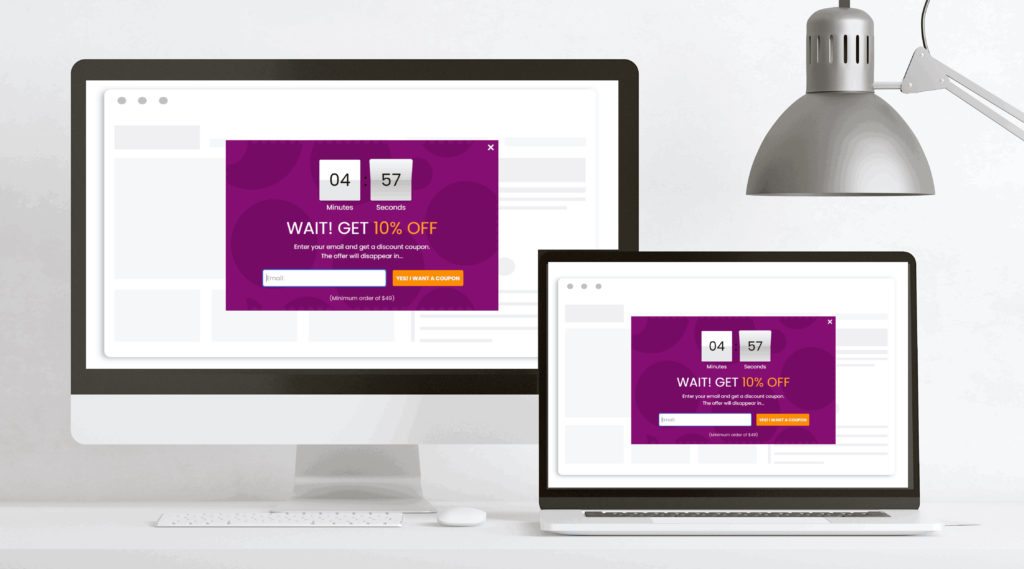In the competitive online landscape, capturing user attention and converting visitors into customers is crucial for any business. One effective tool to achieve this is an exit-intent pop-up. These pop-ups appear when a user is about to leave your website, providing a last chance to engage them. In this blog, we’ll explore what exit-intent pop-ups are, why they matter, and how to implement them effectively on your website.

Table of Contents
ToggleWhat is an Exit-Intent Pop-Up?
An exit-intent pop-up is a message or offer that appears when a user’s mouse moves toward the browser’s exit button or address bar. The goal is to capture their attention before they leave your site, offering them something valuable in return for their engagement, such as a discount, newsletter subscription, or free resource.
Why Exit-Intent Pop-Ups Matter
- Reduce Bounce Rates: By capturing the attention of users who are about to leave, exit-intent pop-ups can help reduce bounce rates and increase time spent on your site.
- Increase Conversions: Offering incentives through pop-ups can encourage users to take action, leading to higher conversion rates.
- Gather User Feedback: Exit-intent pop-ups can be used to solicit feedback from users about their experience, helping you identify areas for improvement.
- Build Your Email List: Encouraging visitors to subscribe to your newsletter before they leave can help you build a valuable email list for future marketing efforts.
How to Implement an Exit-Intent Pop-Up
1: Choose a Pop-Up Tool
Select a pop-up tool or software that suits your needs. Some popular options include:
- OptinMonster: A powerful lead generation tool that allows for easy pop-up creation and customization.
- Sumo: Provides a range of tools for building email lists, including exit-intent pop-ups.
- Hello Bar: Simple to set up and integrates well with various email marketing platforms.
- Elementor (for WordPress): Offers a built-in pop-up builder that includes exit-intent features.
2: Define Your Goals
Before creating your pop-up, clarify what you want to achieve. Common goals include:
- Increasing email subscriptions
- Promoting a special offer or discount
- Encouraging social media follows
- Collecting user feedback
Having a clear goal will help you design an effective pop-up that resonates with your audience.
3: Design the Pop-Up
A well-designed exit-intent pop-up should be visually appealing and user-friendly. Consider the following elements:
- Clear Headline: Use a catchy and concise headline that grabs attention.
- Engaging Copy: Keep the message brief and focused on the value you’re offering.
- Strong Call to Action (CTA): Use actionable language for your CTA, such as “Get 20% Off!” or “Subscribe Now!”
- Attractive Visuals: Incorporate images or graphics that complement your message and enhance engagement.
- Branding: Ensure the pop-up aligns with your brand’s visual identity to maintain consistency.
4: Set Exit-Intent Triggers
Configure your pop-up to appear when a user’s mouse movements indicate they are about to leave the page. Most pop-up tools have built-in exit-intent technology that tracks cursor movement and triggers the pop-up accordingly.
5: Offer Value
To encourage users to stay engaged, provide something of value in your pop-up. This could be:
- A discount code or special offer
- A free eBook, checklist, or resource
- Access to exclusive content or webinars
- A chance to enter a giveaway
Make sure the offer is relevant to your audience and aligns with their needs.
6: Optimize for Mobile
Ensure your exit-intent pop-up is mobile-responsive. Since many users browse on mobile devices, design a version that works seamlessly on smaller screens. Consider using slide-ins or banners instead of traditional pop-ups for mobile users to avoid disruption.
7: Test and Analyze
After implementing your exit-intent pop-up, monitor its performance. Track key metrics such as:
- Conversion rates
- Click-through rates (CTR)
- Bounce rates
- User feedback
Use A/B testing to experiment with different designs, messaging, and offers to determine what works best for your audience.
8: Review and Refine
Regularly review the performance of your exit-intent pop-up and make necessary adjustments based on user feedback and analytics. Continuously refining your approach will help improve its effectiveness over time.
Conclusion
Exit-intent pop-ups can be a powerful tool for capturing user attention and converting visitors into customers. By implementing the steps outlined above, you can create engaging, value-driven pop-ups that enhance user experience and drive conversions. Remember to monitor performance and optimize regularly to maximize the impact of your exit-intent strategy. Start implementing exit-intent pop-ups today and turn potential losses into valuable opportunities for growth!


No responses yet